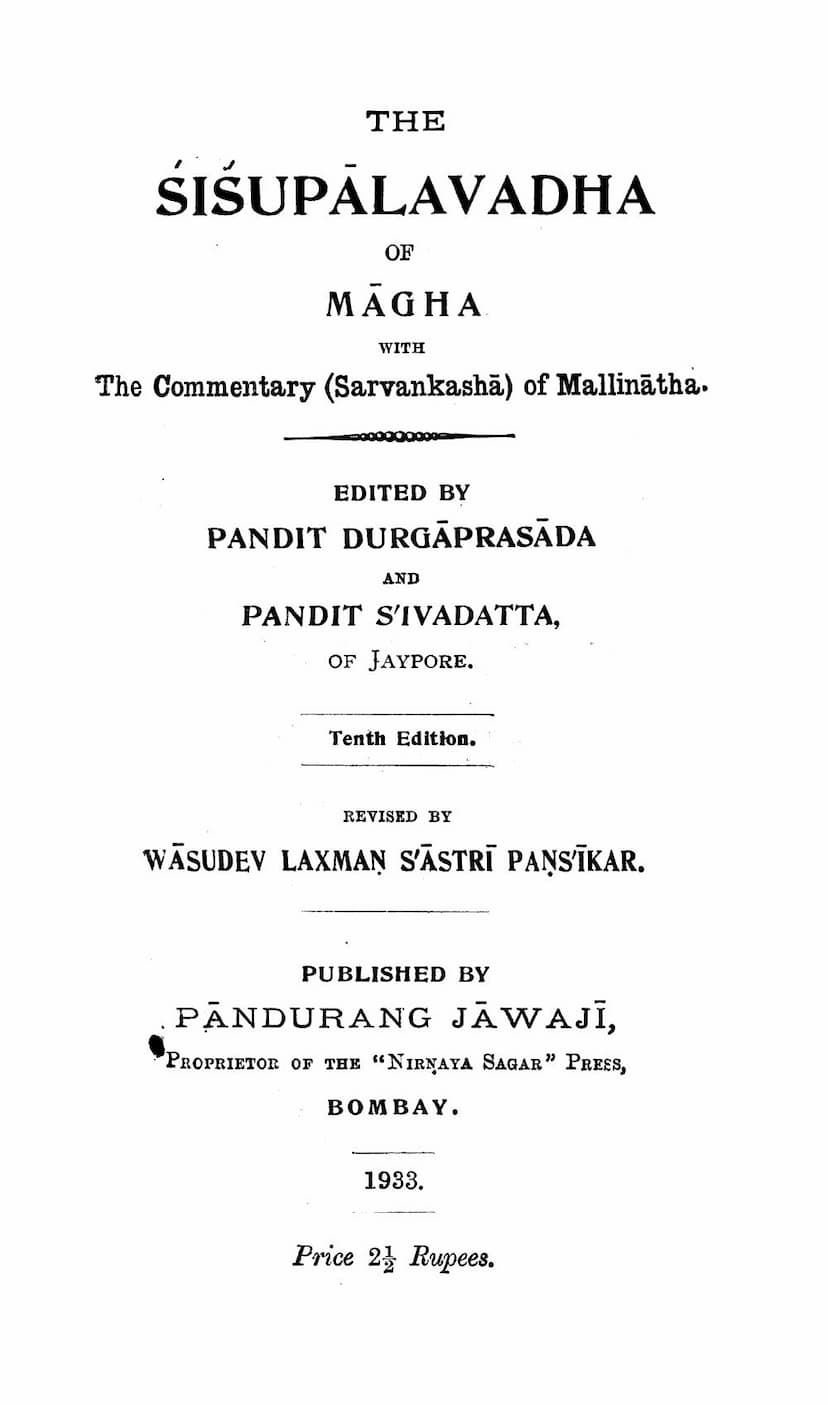Sishupal Vadha
Added to library: September 2, 2025

Summary
The provided text is an excerpt from the "Śiśupālavadha" (The Slaying of Śiśupāla) by the poet Māgha, with the commentary "Sarvaṅkaṣā" by Mallinātha. The publication details indicate it's the tenth edition, published by Pandurang Jawaji in Bombay in 1933. The book is edited by Pandits Durgāprasāda and Śivadatta, and revised by Vāsudeva Laxman Sāstrī Paṇśīkar.
The excerpt itself is the "Upo_d_ghātaḥ" (Introduction or Preface) to the work. It delves into the following key areas:
1. The Importance of Māgha's Śiśupālavadha:
- The introduction emphasizes the high regard for Māgha's Śiśupālavadha within the tradition of Sanskrit epic poetry.
- It places it alongside Kālidāsa's "Laghutrayī" (Minor Triad) and Bhāravi's Kirātārjunīyam and the Naiṣadhīya-caritam as part of the "Bṛhattrayi" (Grand Triad).
- Śiśupālavadha is highlighted for its adherence to the conventions of a Mahākāvya (epic poem), its profound and serious tone, and its rich and instructive use of grammar, making it a highly valuable work for scholars.
2. Biographical Information about the Poet Māgha:
- The introduction attempts to establish the time period and place of the poet Māgha.
- It cites the Bhoja-prabandha and the Prabandha-cintāmaṇi by Merutuṅgācārya as sources for anecdotes about Māgha. These accounts describe his interaction with King Bhoja, his poverty, and his brilliance.
- It also mentions the Prabhāva-carita by Prabhāvacandra, which includes a narrative about Māgha's family and his association with the king of Śrīmāla.
- Based on these accounts, Māgha is estimated to be a contemporary of King Bhoja, who ruled Malwa in the latter half of the 11th century CE. However, the introduction cautions against placing too much faith in these narrative sources due to inconsistencies found in them, especially regarding details about Māgha's family and patronage.
- It suggests that Māgha cannot be placed later than the 9th century CE, as Ānandavardhana, writing in the latter half of the 9th century, quotes verses from Śiśupālavadha in his Dhvanyāloka.
- The text notes that Māgha is believed to have originated from Gujarat.
3. Scholarly Debate on Māgha's Dating:
- The introduction touches upon the scholarly debate regarding Māgha's exact period. It mentions the German scholar Dr. F. Klatt placing Māgha in the early 10th century CE, citing the inscription at the end of the Śiśupālavadha manuscript.
- It also refers to Professor Jacobi, who suggests Māgha lived no later than the middle of the 6th century CE. The author of the introduction finds Jacobi's view more plausible, especially when considering the discrepancies in the Prabhāva-carita and the reliance on oral traditions.
4. Other Works and Commentaries:
- The introduction states that Śiśupālavadha is the only known work by Māgha, although some believe he might have authored other works based on verses attributed to him in other texts like the Subhāṣitāvalī.
- It lists eight known commentaries on Śiśupālavadha, with Mallinātha's Sarvaṅkaṣā being the most comprehensive, widely circulated, and respected among scholars. Mallinātha himself is believed to have lived in the 14th century CE in the Andhra region.
5. Editorial and Publishing Details:
- The introduction details the editorial process for this specific edition, mentioning the efforts to reconcile different manuscripts and include previously unavailable commentary by Vallabhadeva on certain verses.
- It acknowledges the contributions of Pandit Śivadatta Sharma Dadhicha from Jaipur for his grammatical notes and assistance in the revision.
- The publisher expresses hope that the publication will be well-received by scholars and that any shortcomings are due to the editor's limitations.
6. Table of Contents (Vishayānukramaṇī):
- A detailed summary of the 20 cantos (Sargas) of the Śiśupālavadha is provided, outlining the key events and descriptions in each canto, from Nārada's arrival in Dvārakā to the slaying of Śiśupāla and the poet's family lineage.
In essence, the introduction serves as a scholarly preamble, establishing the literary merit of Śiśupālavadha, providing historical context about its poet, and detailing the editorial efforts behind this particular publication. It highlights the poem's significance in Sanskrit literature and the collaborative nature of bringing such a work to print for a wider audience.